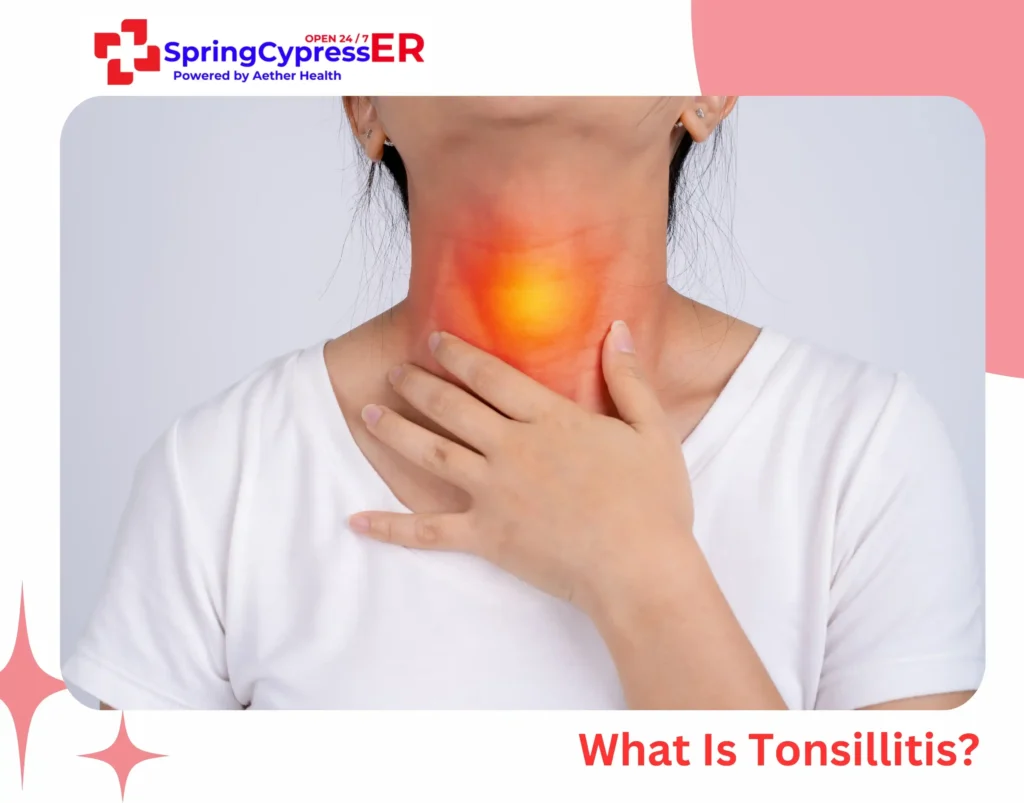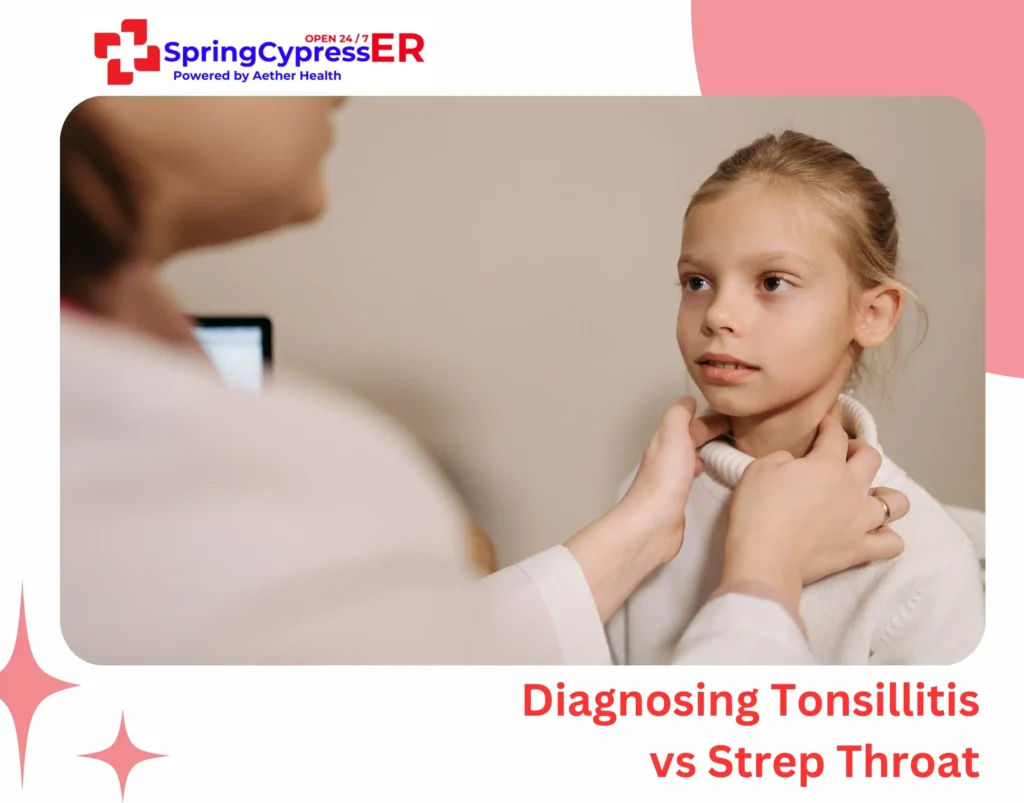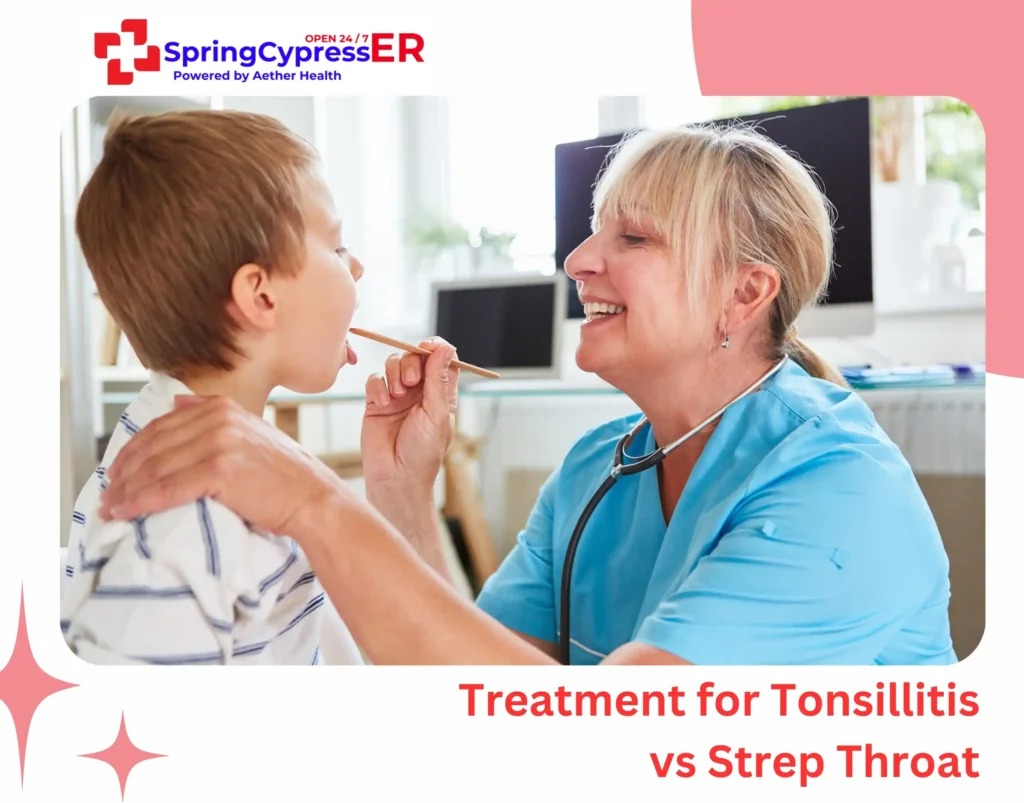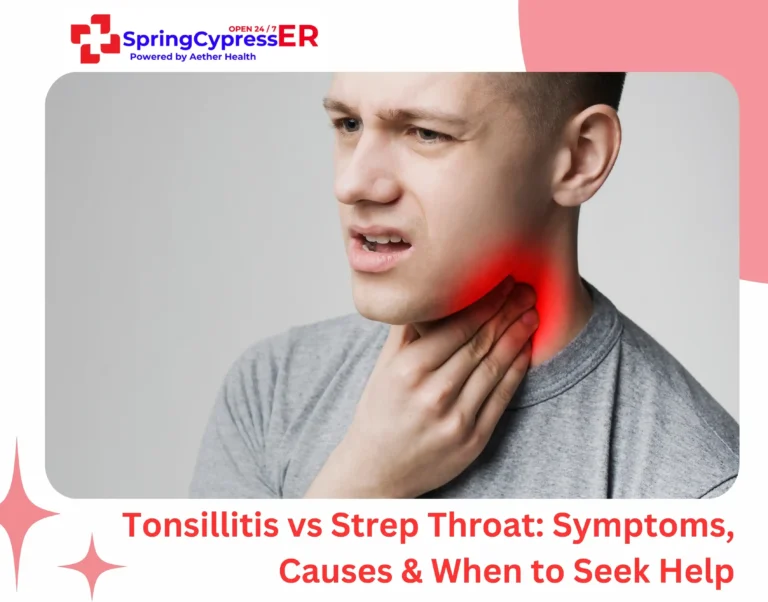Have you ever ignored your sore throat assuming it’s viral tonsillitis that will go away on its own? The visible symptoms appear nearly identical — redness, swelling, and fever — but the causes and risks couldn’t be more different.
Strep throat stems from bacteria and requires antibiotics to prevent complications like ear infections and sinus infections. Tonsillitis, on the other hand, is often viral and typically improves with rest and hydration.
Without proper testing, many patients guess wrong about their throat infection and suffer needlessly for days. Learning the specific differences between tonsillitis vs strep throat helps you decide when to rest at home and when medical care is crucial. Let’s clear up the confusion.
What Is Tonsillitis?

Tonsils are two small lumps of tissue at the back of your throat, one on each side. They’re part of your immune system and help fight infection. Sometimes, they get infected themselves, in a condition called tonsillitis.
Viral tonsillitis is more common and goes away on its own with rest, fluids, and over-the-counter medicines. Bacterial tonsillitis, especially when caused by group A Streptococcus bacteria, needs antibiotics.
Common Symptoms of Tonsillitis
- Sore throat
- Red, swollen tonsils (sometimes with white spots)
- Pain when swallowing
- Fever
- Bad breath
- Swollen glands in your neck
- Scratchy voice or hoarseness
- Stomach aches or refuses to eat in kids
What Is Strep Throat?
Strep throat is a specific type of throat infection caused by bacteria. Tonsillitis can be viral, while bacteria is the only cause of strep throat—specifically Group A Streptococcus (Strep A) bacteria.
If strep goes untreated for weeks, the bacteria may spread to nearby areas causing ear infections and sinus infections. It can also lead to kidney problems and even rheumatic fever, a serious condition that affects the skin, heart, joints, and brain.
Strep throat is highly contagious and spreads easily through coughing, sneezing, or sharing food.
Common Symptoms of Strep Throat
- Sudden, severe sore throat (no coughing)
- Fever (often over 101°F)
- Red, swollen tonsils
- Pain when swallowing
- Swollen lymph nodes in the neck
- Tiny red spots (called petechiae) on the roof of the mouth
- Sometimes ear pain and bad breath
- Kids may get a rash called scarlet fever
Key Differences Between Tonsillitis vs Strep Throat
| Feature | Tonsillitis | Strep Throat |
| Cause | Virus or bacteria | Always caused by bacteria (Strep A) |
| Sore throat | Yes | Yes |
| Fever | Sometimes | Usually high |
| Cough | Common (if viral) | Typically no cough |
| White patches on tonsils | Sometimes | Often |
| Contagious | Yes | Highly Contagious |
| Needs antibiotics | Only if bacterial | Always |
| Duration | 3–10 days | 3–7 days with antibiotics |
| Runny nose or congestion | Common (if viral) | Rare |
| Rash (scarlet fever) | Rare | Sometimes |
Diagnosing Tonsillitis vs Strep Throat

Strep throat vs tonsillitis require slightly different diagnostic approaches. Here’s how doctors typically diagnose each condition.
Diagnosing Strep Throat
- Medical History and Symptoms: The doctor will ask about symptoms like sore throat, fever, or difficulty swallowing.
- Physical Exam: The doctor will examine the throat, to check redness, swelling, and white spots that are common in strep throat. They also feel the lymph nodes in the neck to see if they’re swollen.
- Rapid Strep Test: This test collects the sample from the back of your throat swabbing with a sterile cotton swab. The sample is then tested for the presence of group A Streptococcus bacteria. Results usually come back in 10-20 minutes.
- Throat Culture: If the rapid strep test is negative but the doctor still suspects strep throat, they may send the sample for a culture. A throat culture identifies bacteria in the throat.
Diagnosing Tonsillitis
- Medical History and Symptoms: The doctor will ask about symptoms such as sore throat, difficulty swallowing, and fever.
- Physical Exam: The doctor will inspect the tonsils to see if they’re swollen, red, or have white or yellow patches. They’ll also check the signs of pus or inflammation in the throat.
- Swab or Throat Culture: If the cause is bacterial, the doctor may perform a rapid strep test or a throat culture.
- Viral Tests: One common virus that causes tonsillitis is the Epstein-Barr virus, which causes mononucleosis, also known as “mono” or the kissing disease. Mono can cause a really bad sore throat and swollen tonsils that look a lot like strep. So if your rapid strep test comes back negative, but your symptoms are still severe, your doctor might run a mono test to check for the Epstein-Barr virus.
Treatment for Tonsillitis vs Strep Throat

Tonsillitis Treatment
- Viral: Rest, fluids, warm tea, throat lozenges, and over-the-counter pain relievers (like ibuprofen or acetaminophen).
- Bacterial: If caused by strep, your doctor will prescribe antibiotics.
- Tonsil Removal: Some people get tonsillectomies (surgical removal of tonsils). This happens if you get tonsillitis a lot (like 5+ times a year); you have trouble breathing at night (sleep apnea); antibiotics don’t help. Tonsil removal doesn’t stop all throat infections, but it can reduce how often they happen.
Strep Throat:
- Antibiotics: Common prescription medications like penicillin or amoxicillin are typically prescribed by doctors. These help reduce symptoms, make you less contagious, and prevent complications.
- Supportive care: Rest, fluids, warm saltwater gargles, and throat soothers.
Note: It’s important to finish your full course of antibiotics, even if you start feeling better. Stopping too early can lead to the return of the infection. Treatment decisions should always be made by qualified healthcare providers.
When to See a Doctor
Go to the doctor if you have:
- A sore throat that lasts more than 2 days
- Fever over 101°F (38.3°C)
- Trouble swallowing or breathing
- White patches on the tonsils
- Swollen neck glands
- No cough, but a severe sore throat (a red flag for strep)
- Also, if you’ve been treated for strep or tonsillitis and you’re not getting better within 48 hours, check back in.
Managing Tonsillitis and Strep Throat
So tonsillitis and strep throat can look alike, but they aren’t the same. Tonsillitis may resolve on its own, but what if you have strep? A quick lab test can save you a lot of pain, complications, and a longer recovery.
If you’re feeling lousy and unsure what’s causing your sore throat, ER Spring Cypress can give you answers and get you back to feeling better fast. Don’t let the bacteria spread to nearby areas of your throat. Get fast treatment and stop it in its tracks.
FAQs
1. How can I tell if I have strep throat or just viral tonsillitis?
Strep usually comes on suddenly, with a high fever, no cough, and white patches on the tonsils. Viral tonsillitis often includes symptoms like a runny nose or cough. A rapid strep test or throat culture is the only way to know for sure.
2. Do both tonsillitis and strep throat need antibiotics?
Strep throat always needs antibiotics because it’s caused by bacteria. Tonsillitis only needs antibiotics if it’s bacterial. Most cases are viral and will go away on their own with rest and fluids.
3. Can you have both tonsillitis and strep throat at the same time?
Yes. In fact, strep throat can cause bacterial tonsillitis. So, someone with strep may also have swollen, infected tonsils. But not everyone with tonsillitis has strep.
4. What if I take antibiotics for viral tonsillitis?
Antibiotics don’t work against viruses and using them unnecessarily can lead to allergic reactions, stomach upset, or rashes. Even worse, it can make future infections harder to treat by making you resistant to antibiotics. It means your body may not respond as well to antibiotics when you truly need them.




